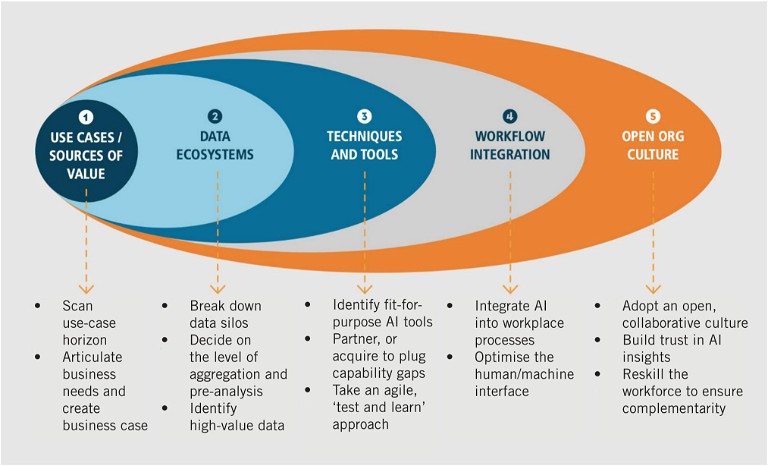Lab Automation: AI in the Lab
Five Steps to Successful AI
Whether lab managers are enthusiastic or apprehensive, AI is coming to the lab. The key to building this advantage is not in the technology, but the approach. Successful adoption of AI requires a genuine, long-term commitment. IPT spoke to Bob Voelkner at LabVantage Solutions about the implications of AI for pharma, what it takes to succeed with this new technology and his five recommended steps for getting started
IPT: What is AI?
Bob Voelkner (BV): The best definition I’ve seen comes from Accenture: “a constellation of many different technologies working together to enable machines to sense, comprehend, act and learn with human-like levels of intelligence.”1 We often equate AI with robots, but practically speaking, AI is simply technology that uses data to make processes such as decision-making or predictions more intelligent, or that can streamline and improve efficiencies within workflows.
IPT: What are the opportunities for labs?
BV: AI opens doors to a range of new possibilities for the labs willing to embrace it. 25% of companies surveyed in a recent McKinsey report credit at least 5% of their top-line profits to AI.2 Meanwhile, AI can make major improvements on the bottom line, particularly in turnaround times, lab throughput and the cost of labour.
We often hear about the ‘lab of the future’, although everyone may have a different definition or vision of it. We believe any ‘lab of the future’ will be defined by its digital connectivity. All instrumentation will be connected and reflected at a digital level to allow for predictive modelling, optimisation, automation and even autonomation.
We define autonomation as ‘automation plus intelligence’ – essentially allowing humans to interact with automated functions. Another word for this would be augmentation; the augmented lab is one where humans are leveraging intelligent data in unprecedented ways for increasing knowledge and better outcomes.
As more labs begin to monitor and visualise lab activity with AI technology, control over lab functions will improve. With improved control, we will see further optimisations of lab performance and scientific research, creating a virtuous cycle of automation and optimisation. The more digitally advanced our labs become, the bigger problems they can begin to address. Labs will be at the heart of solving our most urgent challenges – from climate change, to food safety, to unmet medical needs.
IPT: What does it take to succeed with AI?
BV: A report by Gartner highlights an interesting contradiction. While almost half of CIOs have plans to implement AI, the technology can lead to ‘erroneous outcomes’ up to 85% of the time.3 But this isn’t a result of the technology – it’s in how teams approach it. In pharma in particular, the slow adoption of AI is less about the readiness of the technology than it is about organisations being ill-equipped to deploy it.
Successfully introducing AI requires genuine commitment. It is easy to underestimate how much time, money and talent is required to see success with emerging technologies (Figure 1). That’s why we recommend companies assess their AI readiness and make a firm commitment to the process. If you approach AI as a research project, using language like ‘we’re testing it out’ and ‘playing around with it,’ you’re hampering chances of success. Instead, ask hard questions such as:
- What does success look like?
- How will it be achieved?
- What talent do I need to achieve this?
- What technology do I need to achieve this?
- What budget do I need to achieve this?
- What will this look like in practice?
IPT: What are the five steps to successful AI, and why do they matter?
BV: We recommend labs follow five key steps when starting out with AI. Following these steps in order can help set companies on the right path for their (inevitably long-term) journey towards becoming a ‘lab of the future’.
1. Start with a Use Case
A use case defines a purpose for your AI implementation – one with an intended ROI and business objective. With a use case clearly defined, you can budget, plan and forecast for the road ahead. Developing a proactive strategy and following best practices for your AI implementation is worth the effort.4

Figure 1: Five tips to help companies adopt AI
The ideal use case will look different for every lab, but one common goal for many labs when starting out with the technology is performance analysis. A performance analysis conducted by AI can give unparalleled insights into lab operations, allowing you to quickly spot areas causing problems, whether related to quality, turnaround time or performance in general. Potential use cases include:
- PK-PD modelling – Accelerating pharmacokinetic and toxicology studies through statistical tools and machine learning (ML) models that enable researchers to perform sophisticated analyses
- Immunogenicity analyses – Facilitating immunogenicity cut point analyses and calculations using parametric and non-parametric approaches through a set of out-of-box models
- Formulation studies – Leverage AI-based algorithms on existing data to predict a recipe that uses specific raw materials and meets the desired specification
- Instrument data analysis – A real-time data ingestion pipeline for laboratory instruments, enabling downstream data analysis and predictive maintenance
- Lab resource scheduling – Better utilisation of lab resources (raw material, equipment and manpower) through operation research modelling
- Quality management – Statistical process control and quality-related analytics to identify drivers of poor quality and recommend real-time intervention strategies.
2. Get a Handle on Your Data
For many labs, data problems pose significant obstacles. Without useful, readable data, your AI use case cannot get off the ground, and your lab may join the ranks of those who say they’ve ‘tried AI, but nothing useful came of it’. We see time and time again that most labs consider their data problems to be technology problems when, in reality, issues with data tend to reflect a failure of corporate vision, not of lab technology. Your data needs to flow through a network that reflects the organisation inherent in your business systems. Understanding these connections and building an ecosystem to facilitate data flows is crucial to overall success.
We encourage clients to start with a project leader and work their way down through the organisation to build a ‘digital twin’ of their laboratory, recording everything digitally to allow for monitoring as a baseline step. Then, once your digital lab is generating clean, up-to-date and prepared data in real time, you can move to the next step.
3. Assess Techniques and Technologies
Most labs will need to work with a knowledgeable and experienced scientific data advisor to see real success from AI. In-house talent can struggle to stay up to date with, and capitalise on, the rapidly evolving technology landscape. Data partners can be crucial assets in guiding you through your digital evolution, helping you to navigate and make sense of the models, methodology and language required for your use case. Selecting a partner for this long-term journey is a step that should be taken seriously; we recommend seeking out a firm with deep domain knowledge in AI and analytics, in addition to a broad understanding and experience with your specific industry. AI in auto manufacturing looks very different from AI in a niche pharmaceutical lab, so shop accordingly.
'All instrumentation will be connected and reflected at a digital level to allow for predictive modelling, optimisation, automation and even autonomation'
4. Integrate AI into Workflow
Part of developing a clear use case for your AI implementation is identifying the places within your lab’s workflow where AI can assist to add the most value. Sometimes, this will require organisations to make fundamental changes, reskill employees and change the way they think of certain processes and operations.
Once you have identified high-leverage points for AI integration, look for practical ways to embed AI models into existing software and tools. Occasionally, adding AI into workflows may require the development of new and complementary interfaces. Whenever you add AI into existing workflows, look for ways to improve the human/machine interface. User-friendly and intuitive interfaces and dashboards can make all the difference to employees unsure about embracing the technology, and make it easier and less stressful to bring AI into daily tasks. We also recommend investigating hardware options (mixed reality, robotics, digital assistants) – these can help to bridge the gap between humans and machines, and can help with a range of lab functions, from training and onboarding to manufacturing and more.
5. Adapt a Culture for AI
A final challenge that catches many companies by surprise has nothing to do with technology, and everything to do with human nature. Humans have seemingly always resisted the advent of new technology, but in the case of AI, this opposition is often out of fear for their own economic survival. This fear is unfounded, but companies should recognise it and address employee concerns from the beginning. Companies should educate their team members on the opportunities of AI, reassure them of their continued role in the workplace and demonstrate that the ‘lab of the future’ is a collaboration between humans and machines (just as it is already, to some degree).
Beyond reassuring teams, it’s also important to invest in education and training to ensure team members have the skills and knowledge required to make the most out of their collaboration with AI. With technology taking on of some of the more menial tasks in a lab setting, your team can now focus on more strategic, value-adding work.
References
- Visit: hai.stanford.edu/sites/default/files/2020-09/AI-Definitions-HAI.pdf
- Visit www.mckinsey.com/capabilities/quantumblack/our-insights/global-survey-the-state-of-ai-in-2021
- Visit: www.gartner.com/en/newsroom/press-releases/2018-02-13-gartner-says-nearly-half-of-cios-are-planning-to-deploy-artificial-intelligence
- Visit: hbr.org/2022/02/what-makes-a-company-successful-at-using-ai

LIMS industry pioneer Bob Voelkner, vice president of Sales and Marketing Americas at LabVantage Solutions, oversees customer relationships and promotion of LabVantage’s integrated, intelligent informatics solutions for laboratories across industries and around the world.